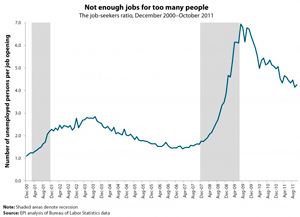Charts Illustrate Scarcity of Jobs, Especially in Industries That Hire People of Color
Author: CFFPP . Date: January 6, 2012Practitioners working with low-income noncustodial parents know first-hand the challenges of helping parents find job openings, then securing and maintaining employment. Charts from the Economic Policy Institute’s State of Working America website illustrate that more than two years after the end of the Great Recession, there are still simply “Not enough jobs for too many people,” and that there are even less jobs in the industries that typically hire low-income people of color.
 The chart at right compares the number of people who are unemployed to the number of job openings—what the Economic Policy Institute (EPI) calls the “job-seekers ratio.” Although the job-seekers ratio has declined since the end of the Great Recession—4.3 to 1, as of October 2011—there were still more than four job-seekers for every job opening. EPI reports:
The chart at right compares the number of people who are unemployed to the number of job openings—what the Economic Policy Institute (EPI) calls the “job-seekers ratio.” Although the job-seekers ratio has declined since the end of the Great Recession—4.3 to 1, as of October 2011—there were still more than four job-seekers for every job opening. EPI reports:
“A job-seekers ratio of more than 4-to-1 means that for more than three out of four unemployed workers, there simply are no jobs. In October [2011], there were 10.6 million more unemployed workers than job openings.”
The lack of job openings is larger in industries that typically hire low-income people of color. Another chart illustrates that the job-seekers ratio is about 4.5 to 1 in the “other services” industries, about 4.6 to 1 in the wholesale and retail trades, about 4.7 to 1 in the transportation, utilities, leisure and hospitality industries, and a very large 6.4 to 1 ratio in the manufacturing industry.
![]() Although the largest job-seekers ratio in this chart—18.5 to 1—is in the construction industry, low-income people of color typically are much less likely to secure these higher-paying jobs, probably due to discrimination and occupational segregation. For more information, see EPI’s “Whiter Jobs, Higher Wages” and CFFPP’s summary of the same report in our April 2011 Policy Briefing that highlights recommendations relevant to practitioners working with low-income noncustodial parents.
Although the largest job-seekers ratio in this chart—18.5 to 1—is in the construction industry, low-income people of color typically are much less likely to secure these higher-paying jobs, probably due to discrimination and occupational segregation. For more information, see EPI’s “Whiter Jobs, Higher Wages” and CFFPP’s summary of the same report in our April 2011 Policy Briefing that highlights recommendations relevant to practitioners working with low-income noncustodial parents.

